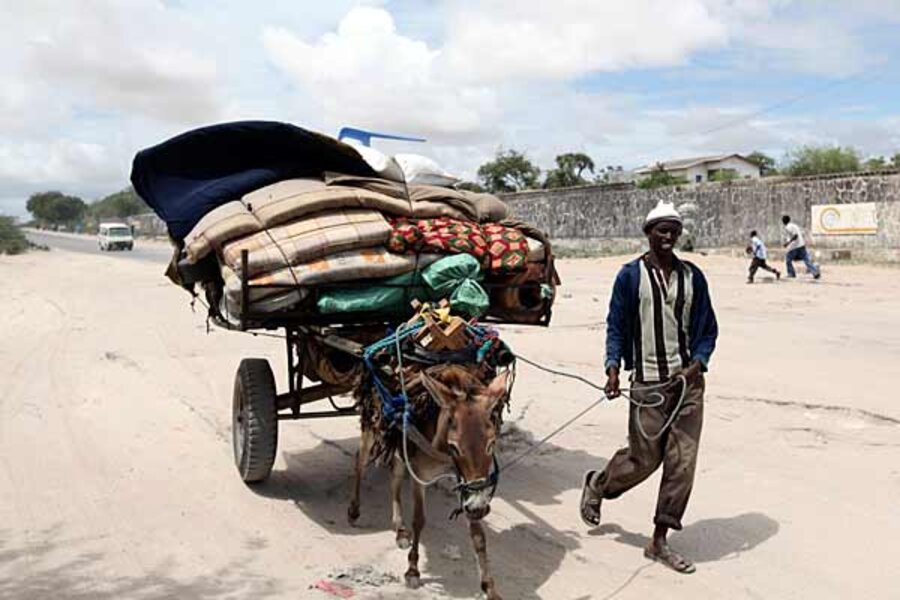Kenya's Somalia operation hits at humanitarian aid
Loading...
| Boston and Lamu, Kenya
After a month-long intervention in Somalia, Kenya’s military can point to a string of battlefront successes against the Somali militant group Al Shabab.
Shabab strongholds in the southern Somali towns of Dhobley, Tabda, Beles Qoqaani and Ras Kamboni have fallen into Kenyan and Somali government hands over the past 36 days, and the once-impenetrable Shabab-held port city of Kismayu – from which Shabab derives millions of dollars in “taxes” on illegal smuggling syndicates – has begun to look vulnerable. Eyewitnesses have reported seeing convoys of Shabab fighters rushing to defend Kismayu, while aid organizations say displaced Somalis are increasingly flowing north toward the government-held capital of Mogadishu ahead of the advancing Kenyan army.
But while battlefield successes may be good news for the Kenyan military and the Somali government, they are less beneficial to ordinary Somalis who were already faced with one of the worst famines in more than 30 years.
“We are deeply concerned by the impact of the intensification of the conflict in Somalia, which threatens to increase internal displacement and may also reduce the ability of aid organizations to provide life-saving assistance to people coping with famine,” said Valerie Amos, the United Nations’ emergency relief coordinator, in a statement. “All parties should refrain from actions that disrupt access and respect international humanitarian law.”
Kenya’s incursion into Somalia is only the latest flare-up in a two-decade long civil war that has sent millions of Somalis from their homes, and forced millions to rely entirely on international food aid for their survival. Somalia’s inability to come up with a government that can bring stability is not just a problem for the Somalis themselves; it also creates a safe haven for criminal gangs to engage in high-seas piracy, as well as a haven for small terrorist groups such as Al-Shabab to operate, and to launch terrorist attacks against Somalia’s neighbors. On July 10, 2010, Shabab took credit for a pair of suicide bombings in Kampala, Uganda, that killed 64 people.
Kenya insists that it had planned its incursion into Somalia for months, and that it coordinates its activities with the Somali transitional government in Mogadishu. But the military operation followed swiftly after a string of kidnappings of Western tourists from the coastal town of Lamu, and Spanish aid workers from the border refugee camps in Dadaab.
One British woman, Judith Tebbutt, was kidnapped and her husband murdered on Sept. 10. A French tourist, Marie Dedieu, was kidnapped from her Lamu home a month later, and subsequently died from lack of medicines. Two aid workers for Medecins Sans Frontieres were kidnapped in mid-October. MSF has largely gone silent about its ongoing effort to secure the safe release of its colleagues, noting that press comments might hinder their release.
Roger Middleton, a Horn of Africa specialist at the British think tank Chatham House, says that the Kenyan military operation puts obvious constraints on continued foreign aid operations and on efforts to secure the release of those foreigners who have been kidnapped.
“The access of international NGOs was not particularly great before the Kenyan incursion, and now it’s even less so,” says Mr. Middleton. With most foreign aid groups now out of southern Somalia, most aid work is being conducted by smaller Somali groups, funded by members of the Somali diaspora, but even these groups are finding difficulty getting clearance to bring in truckloads of food and other goods across the Kenyan border, for fear that they might be supplying Al Shabab, he says.
As for kidnap victims, their situation has become ever more precarious. “The best scenario would be if they have been taken by criminal groups who want money for their release,” says Middleton. Given Shabab’s silence about the kidnappings, Middleton finds it “unlikely” that they had a role in the matter. “If they had a role, I would have thought they would have made a big show of it.”
Far from the battlefield, the Kenyan tourist haven of Lamu – famous for its white sand beaches, warm aquamarine waters, and rich Swahili culture – has been rendered a ghost town by the kidnappings and the conflict.
Usually the months between July and April are peak tourist times in Lamu, with hundreds of Italian, British and German tourists taking charter flights to drink in the Kenyan sunshine. But these days, resorts are empty. Some have shut their doors and gone out of business.
“Most tourists have cancelled their bookings, while others have put their travel to the area on hold,” says Mohammed Ali Abubakar, director of Msafini hotel on Lamu’s Shella beach. “We have sent most of the workers home since we cannot afford to pay them and there is not much to do. We don’t know for how (much) longer this will go on, given that Kenyan soldiers have entered Somalia fighting the militias.”
Hamid Mohammed, manager of the nearby Jannatani Hotel, says he is woried.
“For the last three weeks we have had no visitor, apart from yesterday where two guests walked in,” he says. Security has been beefed up, he adds, with helicopter patrols and Kenyan navy boats on patrol along the beach. But even so, he’s seen his hotel go from 70% capacity to nearly zero. “The beach is almost empty apart from a few local whites who go for a walk during the morning hours.”
The patrols actually end up scaring the locals, Mr. Mohammed says. “The locals here almost (all) know each other. We are not used to this kind of police presence.”
Get daily or weekly updates from CSMonitor.com delivered to your inbox. Sign up today.





